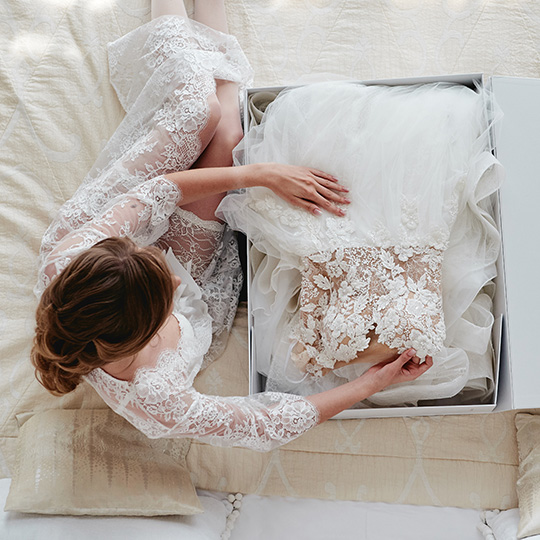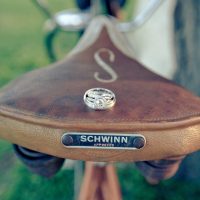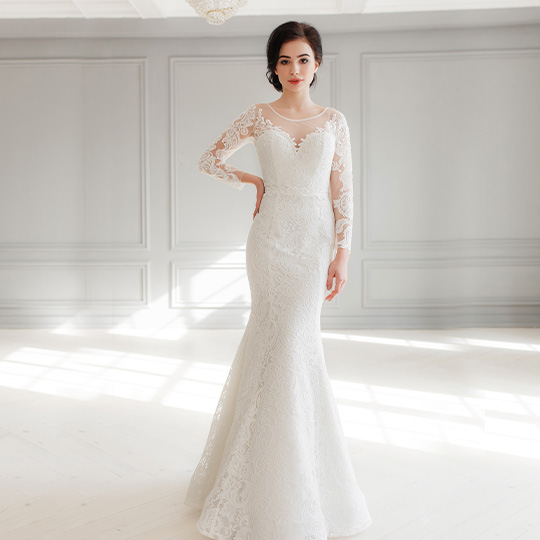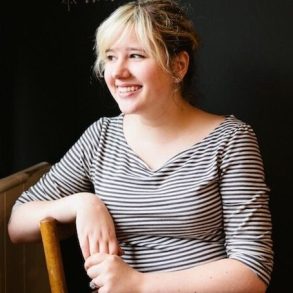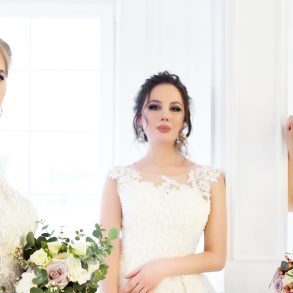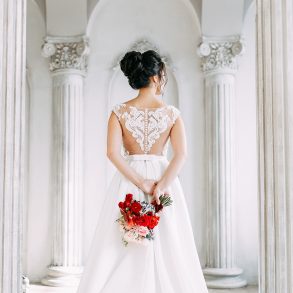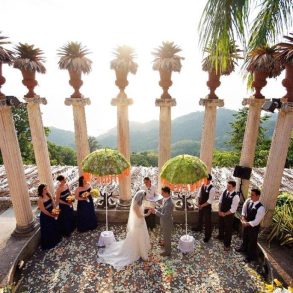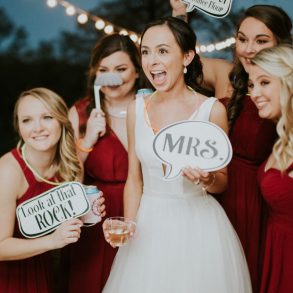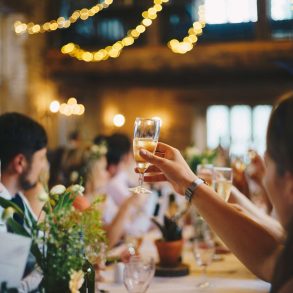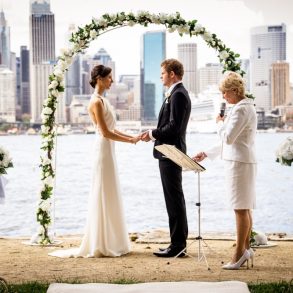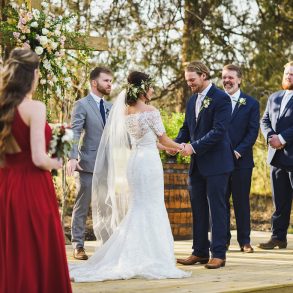Stepping into the world of wedding gowns can be overwhelming, especially if you don’t speak the language. We’ve put together a glossary of common dress-related words and phrases to help you navigate your journey down the aisle like a professional.
Alterations
Alterations are the changes a tailor or seamstress makes to your dress, ensuring it fits you correctly. Shortening the sleeves, taking in the bust, and raising the hem are all examples of alterations.
Alterations may take weeks or even months, so it is important to book your alterations early.
Applique
An applique is a decorative piece of fabric that is attached to your wedding dress. Appliques may feature lace, embroidery, beading, or even 3-dimensional elements like silk flowers.
Beading
Beading is what some people refer to as “bling” or “sparkle.” Small, often metallic glass beads or crystals are attached to the dress in ornate patterns – usually by hand.
Bodice
The bodice is the top part of your dress – the part that covers your neck to your waist. Bodices are usually form-fitting and require a lot of structure, including strategic seaming, boning, cups, and other elements to ensure the ideal fit.
Bolero
A bolero is a short jacket or shrug that slips on over the shoulders. Some brides wear boleros as a modesty measure, while others use them to camouflage their arms and shoulders if they’re a source of insecurity. Boleros can usually be made or purchased in fabric matching the wedding gown.
Boning
Boning is a structural element sewn into the bodice to help it stay up. The “bones” are sturdy-yet-flexible rods that run through channels in the bodice. Boning is usually made of plastic strips or steel spirals. They also allow the bodice to lay smooth against the bride’s torso.
Bustle
A bustle is a dress feature designed to help the bride’s mobility. Dresses with long trains will often have a bustle – some kind of hook or button that attaches the train to the backside of the dress. This helps the train hang elegantly while keeping it out of the way so the bride does not trip over it.
Corset
In wedding gowns, the word corset usually refers to a bodice that laces up in the back. A lace-up closure makes the dress more adjustable to the bride’s body, so it may mean fewer alterations are required.
Darts
Darts are small, triangular seams that help a dress fit more snugly to a bride’s curves. Darts are most commonly used in the bust area of a dress.
Embroidery
Embroidery refers to patterns or images stitched into the dress’s fabric, sometimes with colored thread.
Fitting
A fitting is an appointment with the person working on your dress alterations. They will have you put on your dress so they can note the adjustments needed for the optimal fit. Your alterations specialist may ask you to wear your wedding shoes to the fitting so they can get the length just right. You will most likely need 3-4 fitting appointments.
Hem
The hem is the finished edge at the bottom of the fabric. Usually, the hem refers to the bottom of the skirt; however, if your dress has sleeves or multiple skirt layers at different lengths, you may have numerous hems. Hem changes are some of the most common alterations.
Some dresses have a top-applied hemline. This means the details at the bottom of the dress can be removed, then reapplied once the length is correct.
Hook and Eye
Hooks and eyes are a type of closure used on wedding dresses. They are the same small wire loops and hooks you might find on the band of a bra..
Keyhole
A keyhole refers to a small circular or tear-shaped opening, usually at the back of a dress. Keyhole backs are common with high-necked gowns and lace illusion gowns.
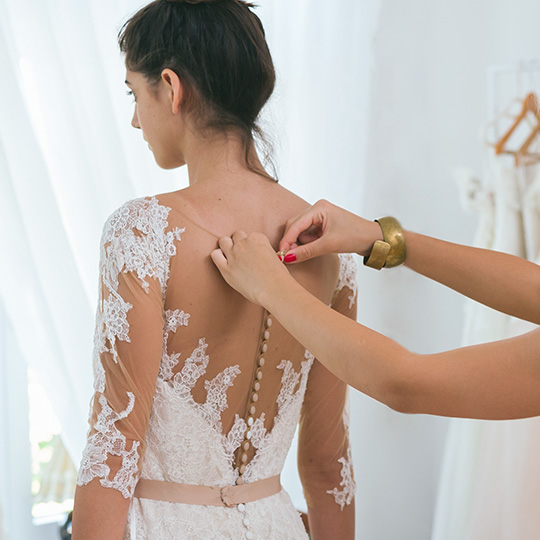
Lace Illusion
Lace illusion dresses use skin-colored mesh to give the appearance of less coverage than they actually offer. Sometimes the mesh goes over the shoulders, giving the impression that lace is defying gravity by clinging to the bride’s body. Other times, the mesh goes into a plunging neckline, allowing for a dramatic look without damaging the dress’s structural integrity.
Let Out
When part of a wedding gown is too small or too tight, a seamstress will “let out” that part of the dress to make more space. In most cases, letting out a dress involves moving a seam closer to the edge of the fabric pieces.
Muslin
Muslin is technically a type of fabric. However, in wedding dress terminology, the word “muslin” usually refers to a mock-up. When a dressmaker builds a custom wedding dress, they will make a muslin out of inexpensive fabric to ensure they have the right fit before cutting into the expensive fabric.
Pleats
Pleats are wide, usually square folds in the design of a dress. Pleats are generally neater and more measured than ruching. Designers use pleats to add visual interest to a dress.
Princess Seam
Princess seaming is a particular cutting technique designers use to fit a bodice to a woman’s curves without using darts or horizontal seams.
Ruching
Ruching is a method of bunching or gathering fabric in an apparently random way. Ruching has a more organic and artistic look than pleating. Designers use ruching to add visual interest to a dress and possibly camouflage parts of the bride’s body that may cause her insecurity.
Sample
A sample is the wedding dress equivalent to a floor model. The boutique keeps one of each dress for brides to try on in-store. Then, when the bride has chosen a gown, the boutique will order a new one in her size.
When bridal stores order new samples, they have sample sales, allowing brides to buy the old sample dresses at a reduced price.
Most sample dresses are a size 10 or 12.
Sash
A sash is a belt that’s tied around the waist of a dress to add color, sparkle, or enhance the dress’s silhouette. Sashes are available in a wide range of colors with varying levels of detail and embellishment.
Satin
Satin is a fabric that is woven in a particular way to give a smooth, glossy finish on one side and a matte finish on the other side.
Satin can be made from a range of materials, including silk, polyester, and rayon.
Read more about other types of wedding dress fabric.
Seam
A seam is a line of stitching that holds two or more pieces of fabric together.
Sequin
A sequin is a small, usually disc-shaped piece of plastic covered in an iridescent or shiny film. They are often sewn onto wedding gowns with beading because of the way they sparkle when they catch the light. Sequins typically have facets, allowing them to reflect light from several different angles.
Silhouette
The term silhouette refers to the overall shape of your dress. Different silhouettes accentuate different physical features. For example, a mermaid silhouette highlights a bride’s hips and backside. Meanwhile, a ballgown gives the appearance of a tiny waist.
Read more about the different types of wedding dress silhouettes.
Silk
Silk is a fabric made from fibers created by silkworms. The fabric is luxurious and expensive to make. It comes in many finishes, including satin, brocade, chiffon, and more.Read more about other types of wedding dress fabric.
Swarovsky
Swarovsky is the brand name for a kind of high-quality Austrian crystals. Not all crystals appearing on wedding dresses are Swarovsky; however, they may be of similar quality. Unlike plastic or lower-quality crystals, Swarovsky crystals are less likely to become discolored with age.
Take In
When part of a wedding gown is too large or too loose, a seamstress will “take in” that part of the dress for a tighter fit. In most cases, taking in a dress involves moving a seam further away from the edge of the fabric pieces.
Train
The train is the long portion at the back of the skirt that trails behind the bride when she walks. Trains come in different lengths, with some dresses featuring no train at all.
Read more about different train lengths.
Tucker
A tucker is a piece of fabric, usually lace, that covers the chest and shoulders, tucking into the bodice. Brides may use tuckers to add modesty to a gown.
Tulle
Tulle is a type of mesh that is often used in wedding gowns. It comes in different textures to change the fullness or the drape of a gown. Veils are also typically made of tulle.
Read more about other types of wedding dress fabric.


